Communication Competency Development
VerifiedAdded on 2023/04/19
|10
|2538
|266
AI Summary
This paper discusses the importance of effective communication in business and explores various aspects of communication competency development. Topics covered include intercultural communication, business writing, non-verbal communication, and more. The author also reflects on how they can apply their learnings in their future career goals.
Contribute Materials
Your contribution can guide someone’s learning journey. Share your
documents today.
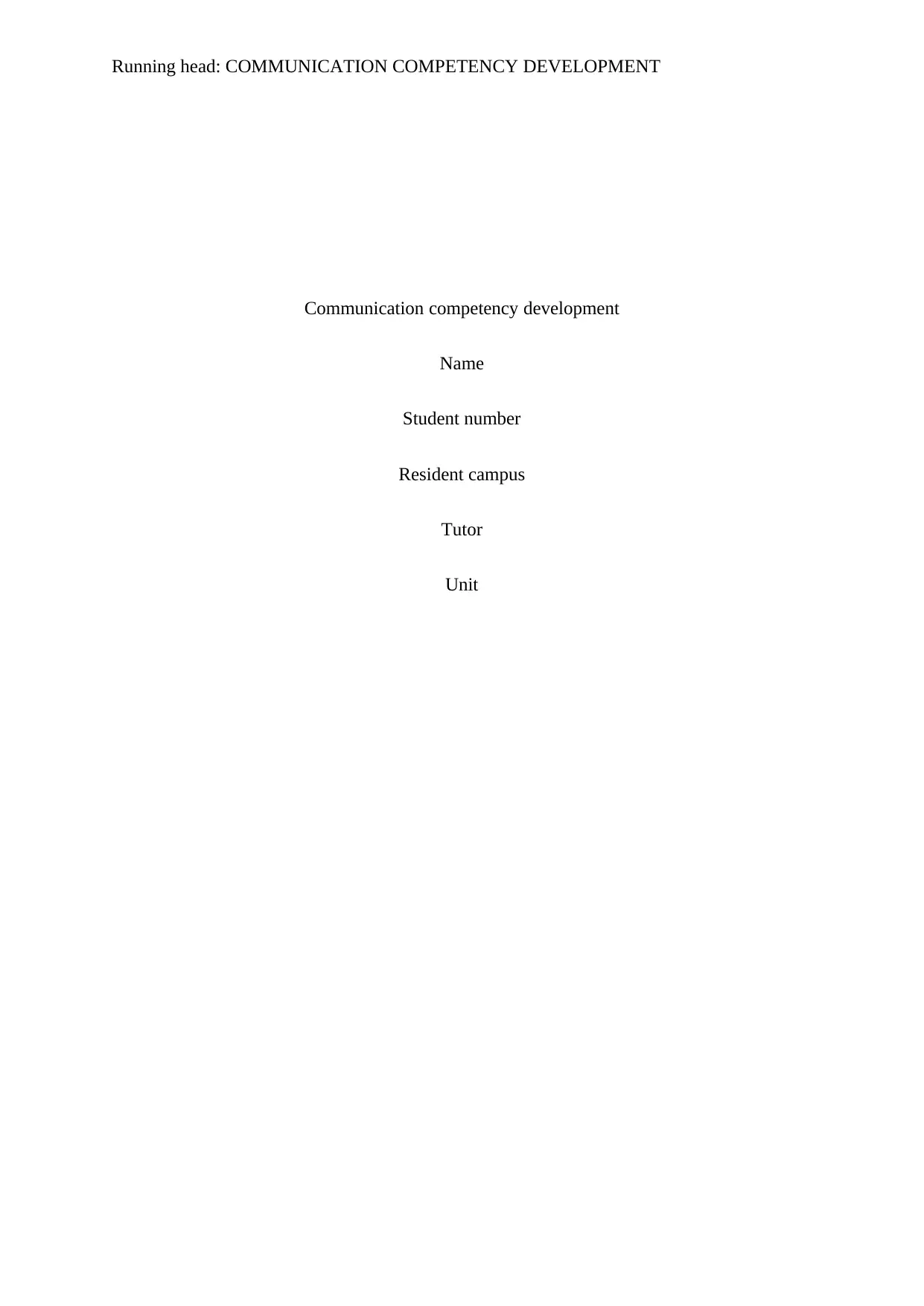
Running head: COMMUNICATION COMPETENCY DEVELOPMENT
Communication competency development
Name
Student number
Resident campus
Tutor
Unit
Communication competency development
Name
Student number
Resident campus
Tutor
Unit
Secure Best Marks with AI Grader
Need help grading? Try our AI Grader for instant feedback on your assignments.

1
COMMUNICATION COMPETENCY DEVELOPMENT
Introduction
In the fast-paced world in which humans live, effective communication is important
as it is a way of life especially in the environment of business. According to Sapp and Zhang
(2009) communication is a major contributor to the success of many goals and objectives set
by the upper management and business leaders. However, various sections of business
management experience increasing uncertainties and tension due to the lack of proper
communication in the work environment. Additionally, understanding various aspects of
business communication and their importance is critical for sufficient technical leadership
and work progress in every organization. Therefore, in this paper, I will summarize what I
have learned from the unit and how I believe I could apply my learnings in my future career
goals. Throughout the paragraphs to follow I will discuss the purpose of communication, the
purpose of business writing, writing a literature review, general and specific purpose of
written academic documents, intercultural communication, the work groups and team,
internal and external organizational communication, intrapersonal and interpersonal
communication, visual aids and non-verbal communication.
Communication Competency Development
Effective communication is important for organizational effectiveness. In this unit, I
have learned that developing proper skills in communication is useful for managers to build
and maintain the self-concept of employees. I have realized that sharing of information
between employees and managers is important as it assists in the reduction of employees’
uncertainties about their duties and responsibilities at the workplace, an aspect which
improves their perception of the work environment and their general well-being. Research
conducted by Hooker (2012) shows that when employees and managers share positive self-
concepts and have a feeling of equal empowerment and practice business relationships that
COMMUNICATION COMPETENCY DEVELOPMENT
Introduction
In the fast-paced world in which humans live, effective communication is important
as it is a way of life especially in the environment of business. According to Sapp and Zhang
(2009) communication is a major contributor to the success of many goals and objectives set
by the upper management and business leaders. However, various sections of business
management experience increasing uncertainties and tension due to the lack of proper
communication in the work environment. Additionally, understanding various aspects of
business communication and their importance is critical for sufficient technical leadership
and work progress in every organization. Therefore, in this paper, I will summarize what I
have learned from the unit and how I believe I could apply my learnings in my future career
goals. Throughout the paragraphs to follow I will discuss the purpose of communication, the
purpose of business writing, writing a literature review, general and specific purpose of
written academic documents, intercultural communication, the work groups and team,
internal and external organizational communication, intrapersonal and interpersonal
communication, visual aids and non-verbal communication.
Communication Competency Development
Effective communication is important for organizational effectiveness. In this unit, I
have learned that developing proper skills in communication is useful for managers to build
and maintain the self-concept of employees. I have realized that sharing of information
between employees and managers is important as it assists in the reduction of employees’
uncertainties about their duties and responsibilities at the workplace, an aspect which
improves their perception of the work environment and their general well-being. Research
conducted by Hooker (2012) shows that when employees and managers share positive self-
concepts and have a feeling of equal empowerment and practice business relationships that
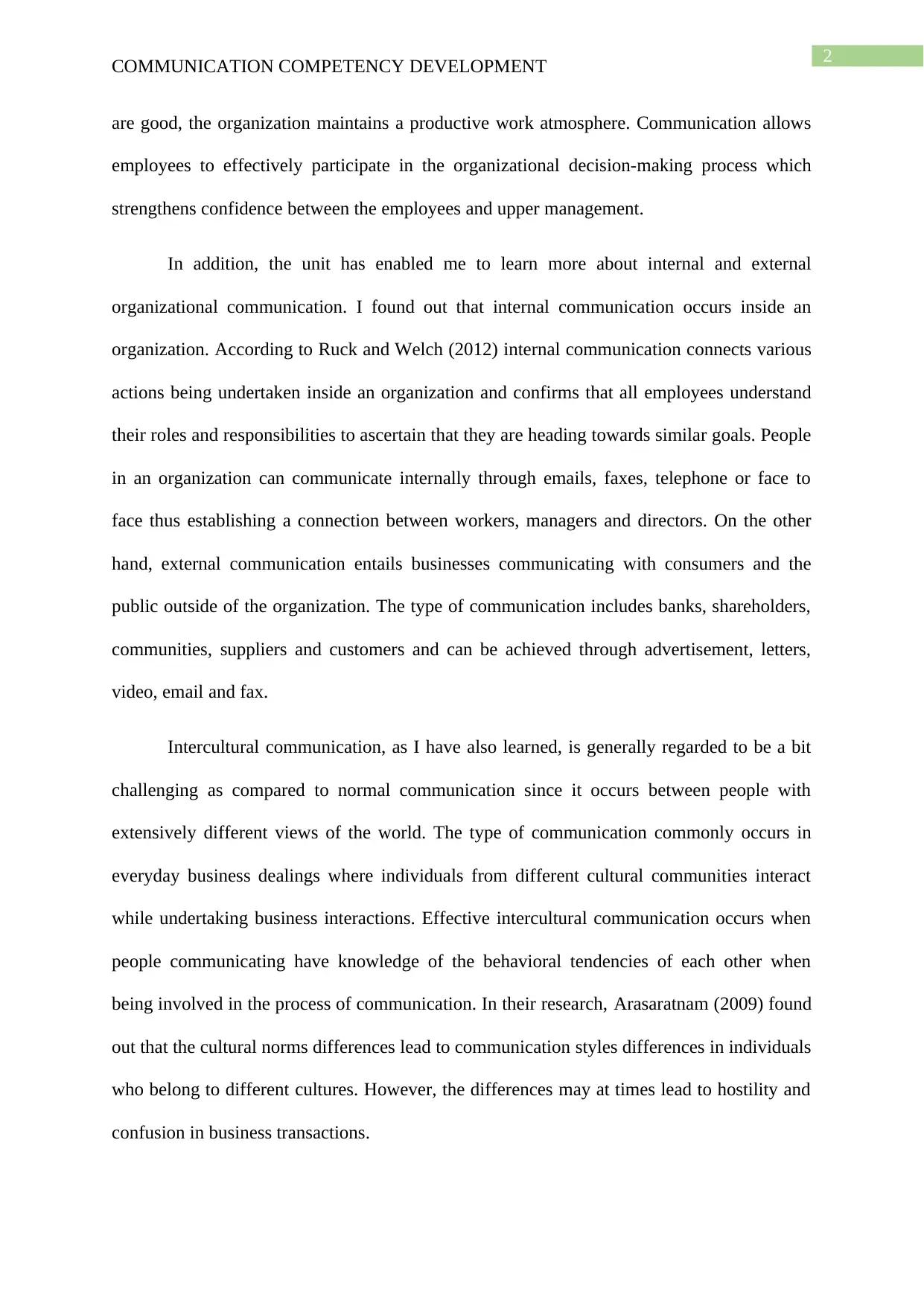
2
COMMUNICATION COMPETENCY DEVELOPMENT
are good, the organization maintains a productive work atmosphere. Communication allows
employees to effectively participate in the organizational decision-making process which
strengthens confidence between the employees and upper management.
In addition, the unit has enabled me to learn more about internal and external
organizational communication. I found out that internal communication occurs inside an
organization. According to Ruck and Welch (2012) internal communication connects various
actions being undertaken inside an organization and confirms that all employees understand
their roles and responsibilities to ascertain that they are heading towards similar goals. People
in an organization can communicate internally through emails, faxes, telephone or face to
face thus establishing a connection between workers, managers and directors. On the other
hand, external communication entails businesses communicating with consumers and the
public outside of the organization. The type of communication includes banks, shareholders,
communities, suppliers and customers and can be achieved through advertisement, letters,
video, email and fax.
Intercultural communication, as I have also learned, is generally regarded to be a bit
challenging as compared to normal communication since it occurs between people with
extensively different views of the world. The type of communication commonly occurs in
everyday business dealings where individuals from different cultural communities interact
while undertaking business interactions. Effective intercultural communication occurs when
people communicating have knowledge of the behavioral tendencies of each other when
being involved in the process of communication. In their research, Arasaratnam (2009) found
out that the cultural norms differences lead to communication styles differences in individuals
who belong to different cultures. However, the differences may at times lead to hostility and
confusion in business transactions.
COMMUNICATION COMPETENCY DEVELOPMENT
are good, the organization maintains a productive work atmosphere. Communication allows
employees to effectively participate in the organizational decision-making process which
strengthens confidence between the employees and upper management.
In addition, the unit has enabled me to learn more about internal and external
organizational communication. I found out that internal communication occurs inside an
organization. According to Ruck and Welch (2012) internal communication connects various
actions being undertaken inside an organization and confirms that all employees understand
their roles and responsibilities to ascertain that they are heading towards similar goals. People
in an organization can communicate internally through emails, faxes, telephone or face to
face thus establishing a connection between workers, managers and directors. On the other
hand, external communication entails businesses communicating with consumers and the
public outside of the organization. The type of communication includes banks, shareholders,
communities, suppliers and customers and can be achieved through advertisement, letters,
video, email and fax.
Intercultural communication, as I have also learned, is generally regarded to be a bit
challenging as compared to normal communication since it occurs between people with
extensively different views of the world. The type of communication commonly occurs in
everyday business dealings where individuals from different cultural communities interact
while undertaking business interactions. Effective intercultural communication occurs when
people communicating have knowledge of the behavioral tendencies of each other when
being involved in the process of communication. In their research, Arasaratnam (2009) found
out that the cultural norms differences lead to communication styles differences in individuals
who belong to different cultures. However, the differences may at times lead to hostility and
confusion in business transactions.
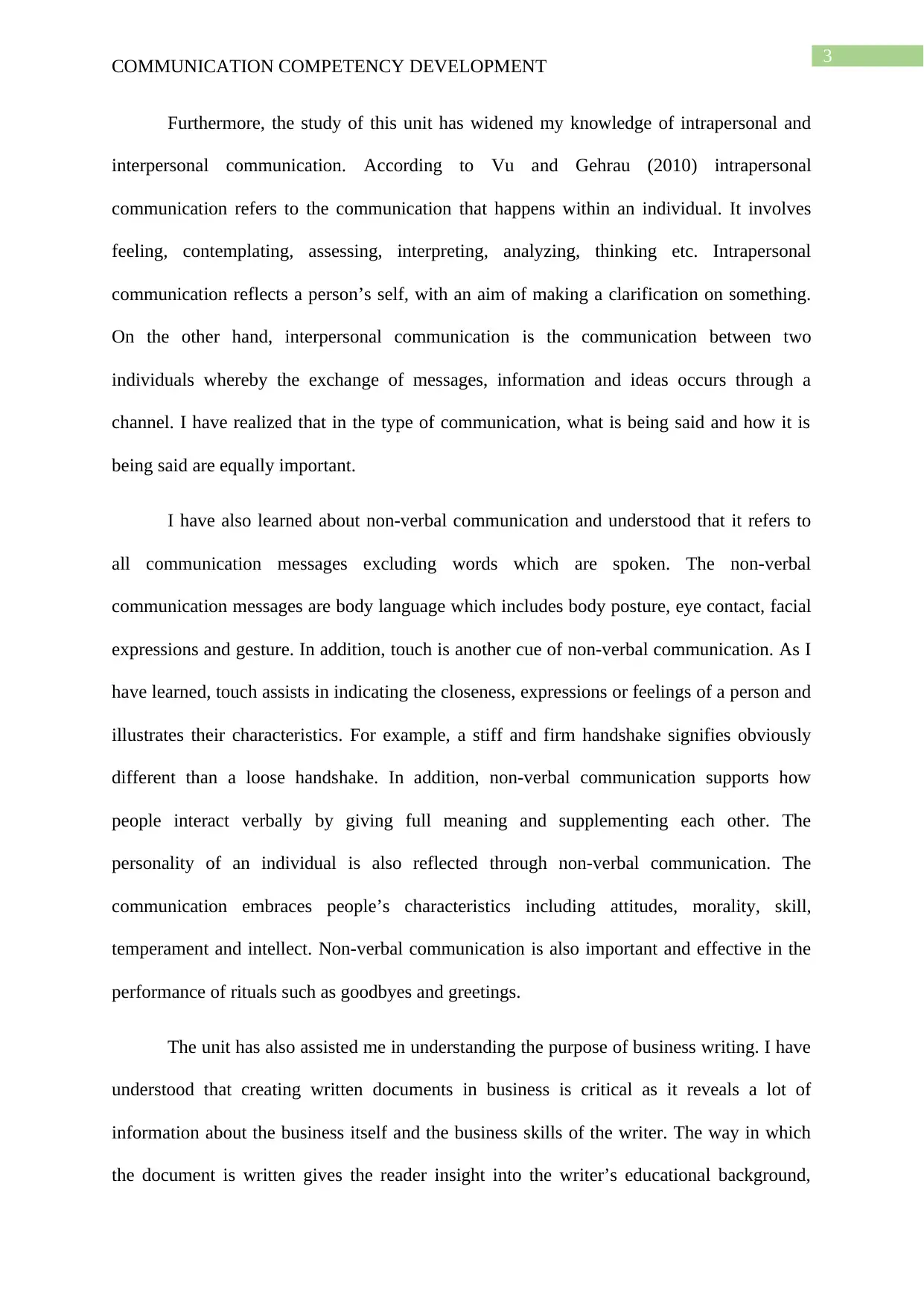
3
COMMUNICATION COMPETENCY DEVELOPMENT
Furthermore, the study of this unit has widened my knowledge of intrapersonal and
interpersonal communication. According to Vu and Gehrau (2010) intrapersonal
communication refers to the communication that happens within an individual. It involves
feeling, contemplating, assessing, interpreting, analyzing, thinking etc. Intrapersonal
communication reflects a person’s self, with an aim of making a clarification on something.
On the other hand, interpersonal communication is the communication between two
individuals whereby the exchange of messages, information and ideas occurs through a
channel. I have realized that in the type of communication, what is being said and how it is
being said are equally important.
I have also learned about non-verbal communication and understood that it refers to
all communication messages excluding words which are spoken. The non-verbal
communication messages are body language which includes body posture, eye contact, facial
expressions and gesture. In addition, touch is another cue of non-verbal communication. As I
have learned, touch assists in indicating the closeness, expressions or feelings of a person and
illustrates their characteristics. For example, a stiff and firm handshake signifies obviously
different than a loose handshake. In addition, non-verbal communication supports how
people interact verbally by giving full meaning and supplementing each other. The
personality of an individual is also reflected through non-verbal communication. The
communication embraces people’s characteristics including attitudes, morality, skill,
temperament and intellect. Non-verbal communication is also important and effective in the
performance of rituals such as goodbyes and greetings.
The unit has also assisted me in understanding the purpose of business writing. I have
understood that creating written documents in business is critical as it reveals a lot of
information about the business itself and the business skills of the writer. The way in which
the document is written gives the reader insight into the writer’s educational background,
COMMUNICATION COMPETENCY DEVELOPMENT
Furthermore, the study of this unit has widened my knowledge of intrapersonal and
interpersonal communication. According to Vu and Gehrau (2010) intrapersonal
communication refers to the communication that happens within an individual. It involves
feeling, contemplating, assessing, interpreting, analyzing, thinking etc. Intrapersonal
communication reflects a person’s self, with an aim of making a clarification on something.
On the other hand, interpersonal communication is the communication between two
individuals whereby the exchange of messages, information and ideas occurs through a
channel. I have realized that in the type of communication, what is being said and how it is
being said are equally important.
I have also learned about non-verbal communication and understood that it refers to
all communication messages excluding words which are spoken. The non-verbal
communication messages are body language which includes body posture, eye contact, facial
expressions and gesture. In addition, touch is another cue of non-verbal communication. As I
have learned, touch assists in indicating the closeness, expressions or feelings of a person and
illustrates their characteristics. For example, a stiff and firm handshake signifies obviously
different than a loose handshake. In addition, non-verbal communication supports how
people interact verbally by giving full meaning and supplementing each other. The
personality of an individual is also reflected through non-verbal communication. The
communication embraces people’s characteristics including attitudes, morality, skill,
temperament and intellect. Non-verbal communication is also important and effective in the
performance of rituals such as goodbyes and greetings.
The unit has also assisted me in understanding the purpose of business writing. I have
understood that creating written documents in business is critical as it reveals a lot of
information about the business itself and the business skills of the writer. The way in which
the document is written gives the reader insight into the writer’s educational background,
Secure Best Marks with AI Grader
Need help grading? Try our AI Grader for instant feedback on your assignments.
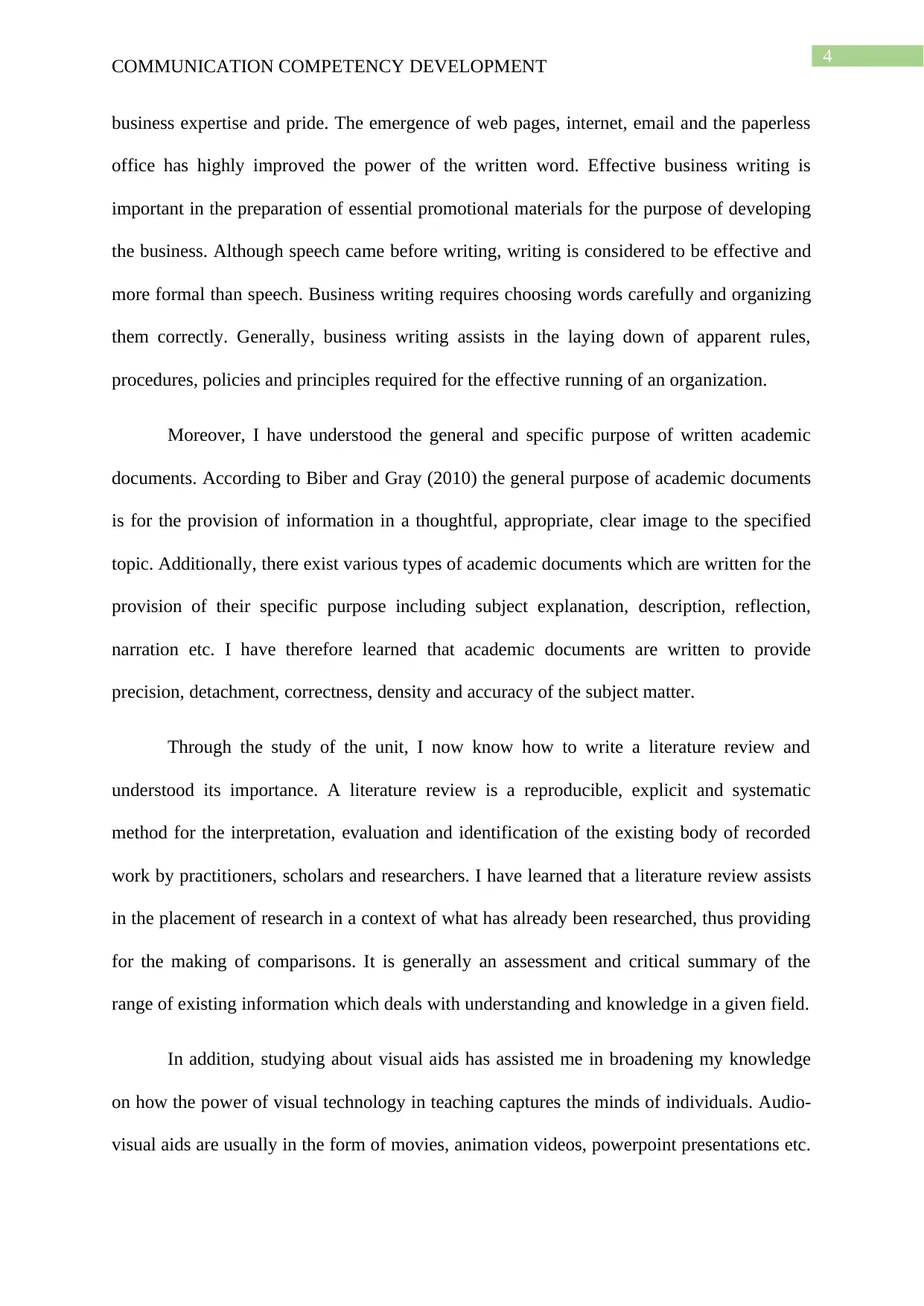
4
COMMUNICATION COMPETENCY DEVELOPMENT
business expertise and pride. The emergence of web pages, internet, email and the paperless
office has highly improved the power of the written word. Effective business writing is
important in the preparation of essential promotional materials for the purpose of developing
the business. Although speech came before writing, writing is considered to be effective and
more formal than speech. Business writing requires choosing words carefully and organizing
them correctly. Generally, business writing assists in the laying down of apparent rules,
procedures, policies and principles required for the effective running of an organization.
Moreover, I have understood the general and specific purpose of written academic
documents. According to Biber and Gray (2010) the general purpose of academic documents
is for the provision of information in a thoughtful, appropriate, clear image to the specified
topic. Additionally, there exist various types of academic documents which are written for the
provision of their specific purpose including subject explanation, description, reflection,
narration etc. I have therefore learned that academic documents are written to provide
precision, detachment, correctness, density and accuracy of the subject matter.
Through the study of the unit, I now know how to write a literature review and
understood its importance. A literature review is a reproducible, explicit and systematic
method for the interpretation, evaluation and identification of the existing body of recorded
work by practitioners, scholars and researchers. I have learned that a literature review assists
in the placement of research in a context of what has already been researched, thus providing
for the making of comparisons. It is generally an assessment and critical summary of the
range of existing information which deals with understanding and knowledge in a given field.
In addition, studying about visual aids has assisted me in broadening my knowledge
on how the power of visual technology in teaching captures the minds of individuals. Audio-
visual aids are usually in the form of movies, animation videos, powerpoint presentations etc.
COMMUNICATION COMPETENCY DEVELOPMENT
business expertise and pride. The emergence of web pages, internet, email and the paperless
office has highly improved the power of the written word. Effective business writing is
important in the preparation of essential promotional materials for the purpose of developing
the business. Although speech came before writing, writing is considered to be effective and
more formal than speech. Business writing requires choosing words carefully and organizing
them correctly. Generally, business writing assists in the laying down of apparent rules,
procedures, policies and principles required for the effective running of an organization.
Moreover, I have understood the general and specific purpose of written academic
documents. According to Biber and Gray (2010) the general purpose of academic documents
is for the provision of information in a thoughtful, appropriate, clear image to the specified
topic. Additionally, there exist various types of academic documents which are written for the
provision of their specific purpose including subject explanation, description, reflection,
narration etc. I have therefore learned that academic documents are written to provide
precision, detachment, correctness, density and accuracy of the subject matter.
Through the study of the unit, I now know how to write a literature review and
understood its importance. A literature review is a reproducible, explicit and systematic
method for the interpretation, evaluation and identification of the existing body of recorded
work by practitioners, scholars and researchers. I have learned that a literature review assists
in the placement of research in a context of what has already been researched, thus providing
for the making of comparisons. It is generally an assessment and critical summary of the
range of existing information which deals with understanding and knowledge in a given field.
In addition, studying about visual aids has assisted me in broadening my knowledge
on how the power of visual technology in teaching captures the minds of individuals. Audio-
visual aids are usually in the form of movies, animation videos, powerpoint presentations etc.

5
COMMUNICATION COMPETENCY DEVELOPMENT
which are especially useful when there is a large number of learners in a single lecture. As I
have realized, visual aids support lectures by emphasizing on key points being explained. The
projection of printed or written information on transparencies via a computer-based system or
an overhead projector (OHP) assists learners to quickly grab the concept being taught. Media
projectors and power point slides have greatly revolutionized teaching since audio-visual
clips and texts can easily be played on power point slides. Animations provide a visual
simulation which is effective in sustaining understanding and interest among learners.
Additionally, students prefer being taught using visual aids as opposed to blackboard
traditional lectures. However, for effectively deriving the benefits of audio visual aids, their
optimum use is recommended.
Lastly, the unit has enabled me to learn more about business teams and workgroups.
Generally, business teams and groups are important in the association and performance of a
business as they play an important role in the breakdown and achievement of organizational
goals and objectives. Joshi, Lazarova and Liao (2009) define a team as a small group of
individuals having complimentary abilities and skills and have a commitment towards a
common approach and goal for which they hold themselves accountable. Diverse and
multiple opinions are presented where inferred agreement or a vote is undertaken to reach a
final decision. On the other hand, a workgroup is a small fraction of employees having
complimentary abilities and skills and are accountable to the leader through his goals and
approaches.
Literature Review
Intercultural communication is important for various reasons. According to Baker
(2011) intercultural communication plays a great role in global economics leading to the
production of positive economic outcomes. For example, on a daily basis from the global
COMMUNICATION COMPETENCY DEVELOPMENT
which are especially useful when there is a large number of learners in a single lecture. As I
have realized, visual aids support lectures by emphasizing on key points being explained. The
projection of printed or written information on transparencies via a computer-based system or
an overhead projector (OHP) assists learners to quickly grab the concept being taught. Media
projectors and power point slides have greatly revolutionized teaching since audio-visual
clips and texts can easily be played on power point slides. Animations provide a visual
simulation which is effective in sustaining understanding and interest among learners.
Additionally, students prefer being taught using visual aids as opposed to blackboard
traditional lectures. However, for effectively deriving the benefits of audio visual aids, their
optimum use is recommended.
Lastly, the unit has enabled me to learn more about business teams and workgroups.
Generally, business teams and groups are important in the association and performance of a
business as they play an important role in the breakdown and achievement of organizational
goals and objectives. Joshi, Lazarova and Liao (2009) define a team as a small group of
individuals having complimentary abilities and skills and have a commitment towards a
common approach and goal for which they hold themselves accountable. Diverse and
multiple opinions are presented where inferred agreement or a vote is undertaken to reach a
final decision. On the other hand, a workgroup is a small fraction of employees having
complimentary abilities and skills and are accountable to the leader through his goals and
approaches.
Literature Review
Intercultural communication is important for various reasons. According to Baker
(2011) intercultural communication plays a great role in global economics leading to the
production of positive economic outcomes. For example, on a daily basis from the global
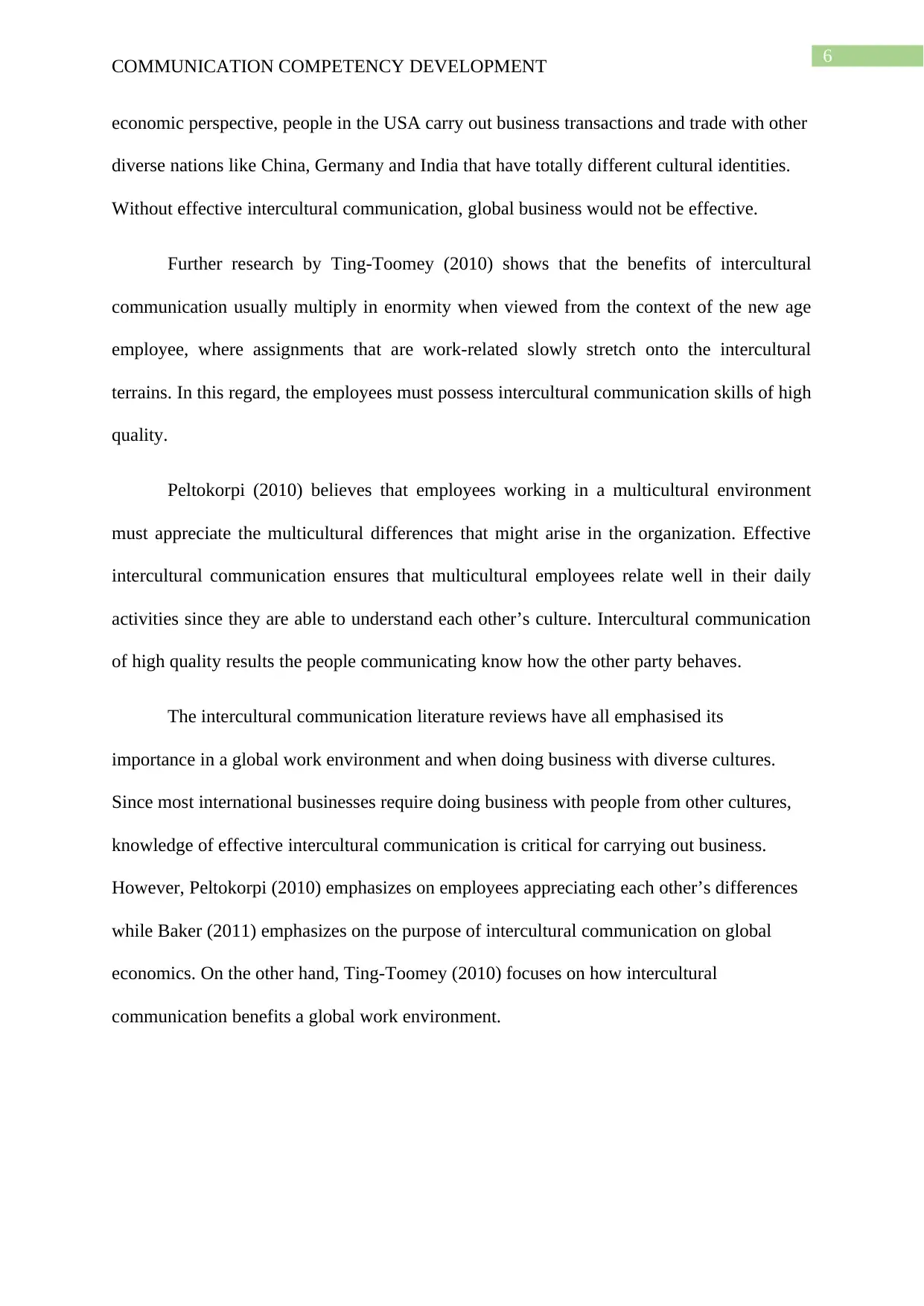
6
COMMUNICATION COMPETENCY DEVELOPMENT
economic perspective, people in the USA carry out business transactions and trade with other
diverse nations like China, Germany and India that have totally different cultural identities.
Without effective intercultural communication, global business would not be effective.
Further research by Ting-Toomey (2010) shows that the benefits of intercultural
communication usually multiply in enormity when viewed from the context of the new age
employee, where assignments that are work-related slowly stretch onto the intercultural
terrains. In this regard, the employees must possess intercultural communication skills of high
quality.
Peltokorpi (2010) believes that employees working in a multicultural environment
must appreciate the multicultural differences that might arise in the organization. Effective
intercultural communication ensures that multicultural employees relate well in their daily
activities since they are able to understand each other’s culture. Intercultural communication
of high quality results the people communicating know how the other party behaves.
The intercultural communication literature reviews have all emphasised its
importance in a global work environment and when doing business with diverse cultures.
Since most international businesses require doing business with people from other cultures,
knowledge of effective intercultural communication is critical for carrying out business.
However, Peltokorpi (2010) emphasizes on employees appreciating each other’s differences
while Baker (2011) emphasizes on the purpose of intercultural communication on global
economics. On the other hand, Ting-Toomey (2010) focuses on how intercultural
communication benefits a global work environment.
COMMUNICATION COMPETENCY DEVELOPMENT
economic perspective, people in the USA carry out business transactions and trade with other
diverse nations like China, Germany and India that have totally different cultural identities.
Without effective intercultural communication, global business would not be effective.
Further research by Ting-Toomey (2010) shows that the benefits of intercultural
communication usually multiply in enormity when viewed from the context of the new age
employee, where assignments that are work-related slowly stretch onto the intercultural
terrains. In this regard, the employees must possess intercultural communication skills of high
quality.
Peltokorpi (2010) believes that employees working in a multicultural environment
must appreciate the multicultural differences that might arise in the organization. Effective
intercultural communication ensures that multicultural employees relate well in their daily
activities since they are able to understand each other’s culture. Intercultural communication
of high quality results the people communicating know how the other party behaves.
The intercultural communication literature reviews have all emphasised its
importance in a global work environment and when doing business with diverse cultures.
Since most international businesses require doing business with people from other cultures,
knowledge of effective intercultural communication is critical for carrying out business.
However, Peltokorpi (2010) emphasizes on employees appreciating each other’s differences
while Baker (2011) emphasizes on the purpose of intercultural communication on global
economics. On the other hand, Ting-Toomey (2010) focuses on how intercultural
communication benefits a global work environment.
Paraphrase This Document
Need a fresh take? Get an instant paraphrase of this document with our AI Paraphraser
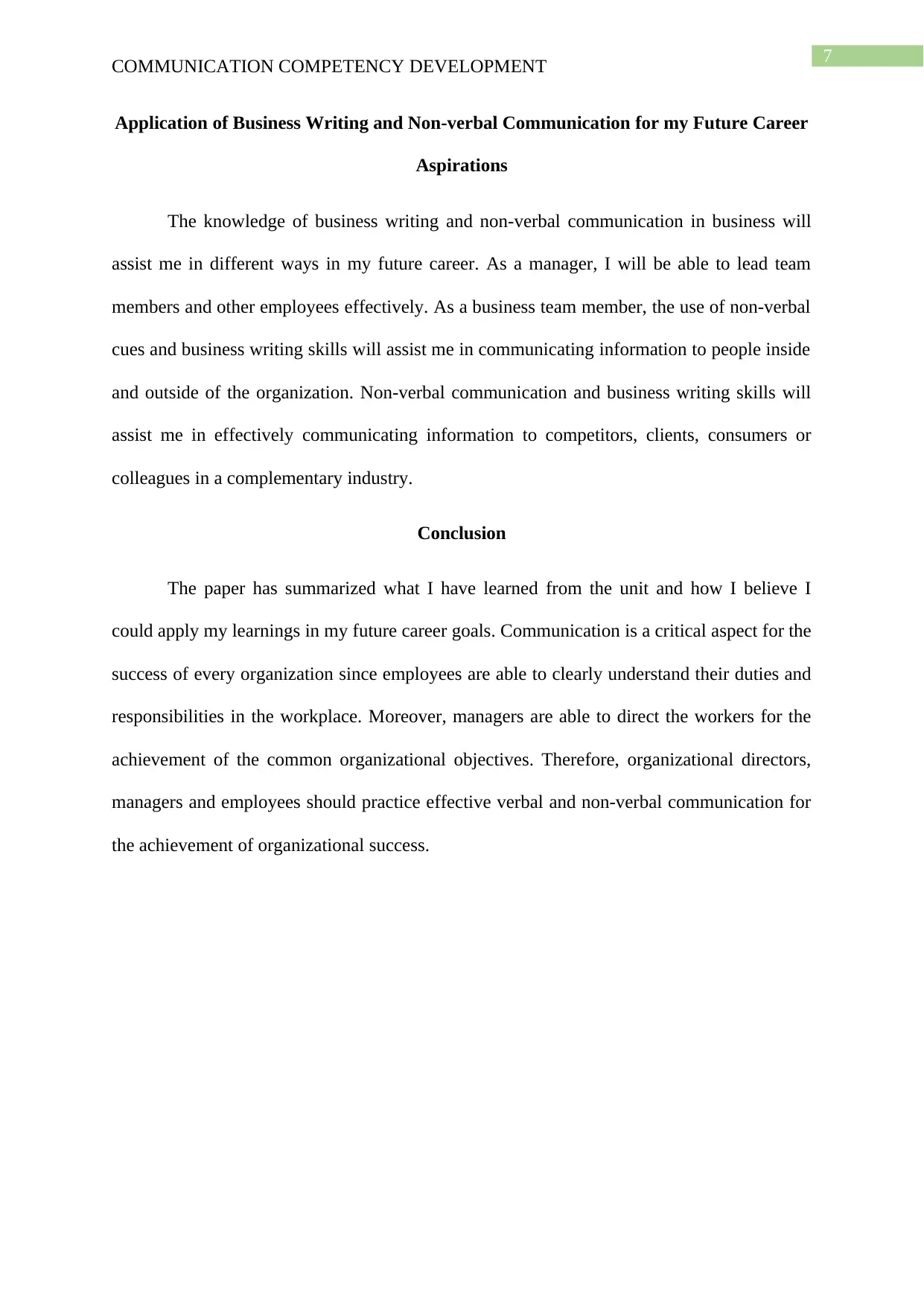
7
COMMUNICATION COMPETENCY DEVELOPMENT
Application of Business Writing and Non-verbal Communication for my Future Career
Aspirations
The knowledge of business writing and non-verbal communication in business will
assist me in different ways in my future career. As a manager, I will be able to lead team
members and other employees effectively. As a business team member, the use of non-verbal
cues and business writing skills will assist me in communicating information to people inside
and outside of the organization. Non-verbal communication and business writing skills will
assist me in effectively communicating information to competitors, clients, consumers or
colleagues in a complementary industry.
Conclusion
The paper has summarized what I have learned from the unit and how I believe I
could apply my learnings in my future career goals. Communication is a critical aspect for the
success of every organization since employees are able to clearly understand their duties and
responsibilities in the workplace. Moreover, managers are able to direct the workers for the
achievement of the common organizational objectives. Therefore, organizational directors,
managers and employees should practice effective verbal and non-verbal communication for
the achievement of organizational success.
COMMUNICATION COMPETENCY DEVELOPMENT
Application of Business Writing and Non-verbal Communication for my Future Career
Aspirations
The knowledge of business writing and non-verbal communication in business will
assist me in different ways in my future career. As a manager, I will be able to lead team
members and other employees effectively. As a business team member, the use of non-verbal
cues and business writing skills will assist me in communicating information to people inside
and outside of the organization. Non-verbal communication and business writing skills will
assist me in effectively communicating information to competitors, clients, consumers or
colleagues in a complementary industry.
Conclusion
The paper has summarized what I have learned from the unit and how I believe I
could apply my learnings in my future career goals. Communication is a critical aspect for the
success of every organization since employees are able to clearly understand their duties and
responsibilities in the workplace. Moreover, managers are able to direct the workers for the
achievement of the common organizational objectives. Therefore, organizational directors,
managers and employees should practice effective verbal and non-verbal communication for
the achievement of organizational success.
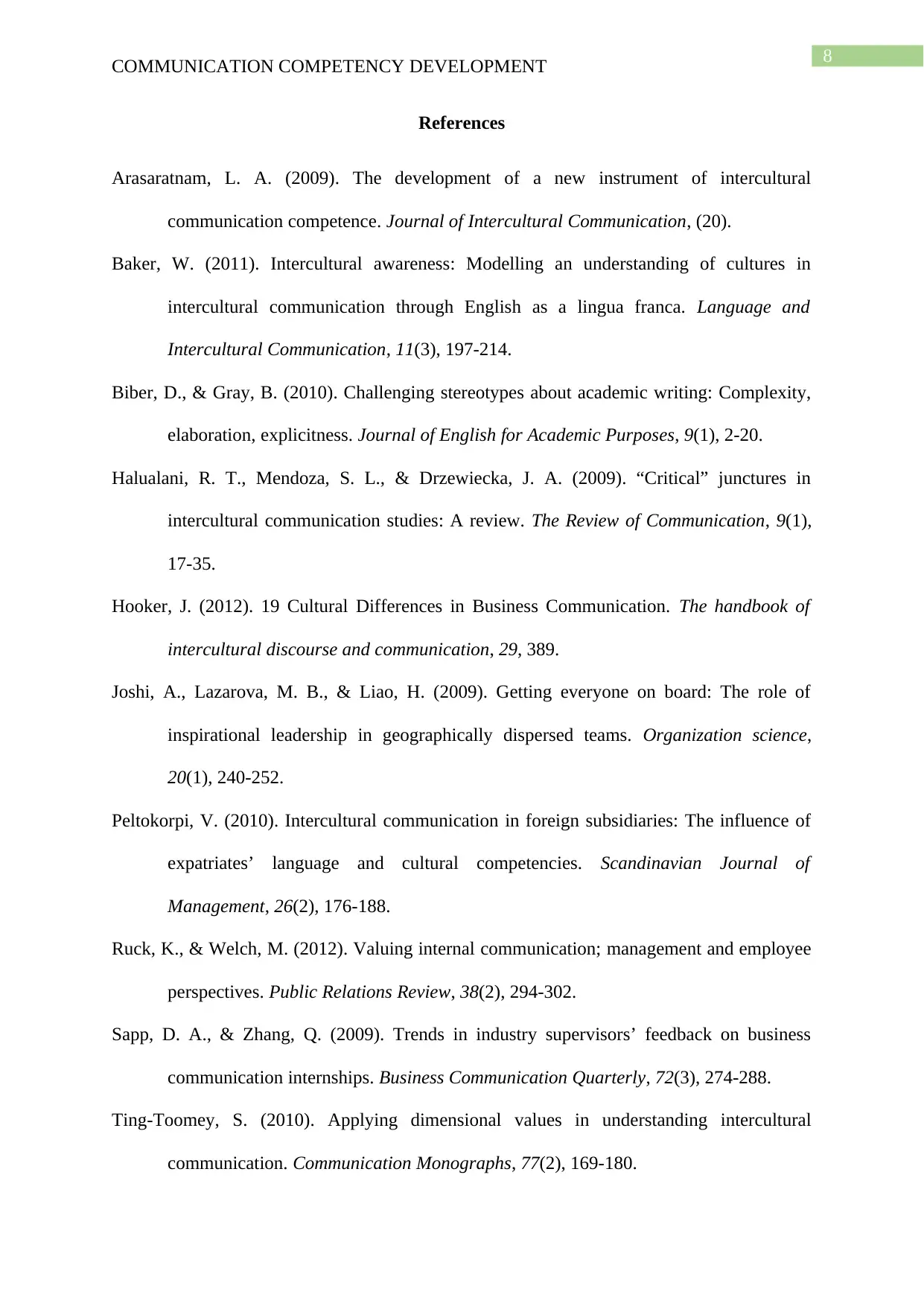
8
COMMUNICATION COMPETENCY DEVELOPMENT
References
Arasaratnam, L. A. (2009). The development of a new instrument of intercultural
communication competence. Journal of Intercultural Communication, (20).
Baker, W. (2011). Intercultural awareness: Modelling an understanding of cultures in
intercultural communication through English as a lingua franca. Language and
Intercultural Communication, 11(3), 197-214.
Biber, D., & Gray, B. (2010). Challenging stereotypes about academic writing: Complexity,
elaboration, explicitness. Journal of English for Academic Purposes, 9(1), 2-20.
Halualani, R. T., Mendoza, S. L., & Drzewiecka, J. A. (2009). “Critical” junctures in
intercultural communication studies: A review. The Review of Communication, 9(1),
17-35.
Hooker, J. (2012). 19 Cultural Differences in Business Communication. The handbook of
intercultural discourse and communication, 29, 389.
Joshi, A., Lazarova, M. B., & Liao, H. (2009). Getting everyone on board: The role of
inspirational leadership in geographically dispersed teams. Organization science,
20(1), 240-252.
Peltokorpi, V. (2010). Intercultural communication in foreign subsidiaries: The influence of
expatriates’ language and cultural competencies. Scandinavian Journal of
Management, 26(2), 176-188.
Ruck, K., & Welch, M. (2012). Valuing internal communication; management and employee
perspectives. Public Relations Review, 38(2), 294-302.
Sapp, D. A., & Zhang, Q. (2009). Trends in industry supervisors’ feedback on business
communication internships. Business Communication Quarterly, 72(3), 274-288.
Ting-Toomey, S. (2010). Applying dimensional values in understanding intercultural
communication. Communication Monographs, 77(2), 169-180.
COMMUNICATION COMPETENCY DEVELOPMENT
References
Arasaratnam, L. A. (2009). The development of a new instrument of intercultural
communication competence. Journal of Intercultural Communication, (20).
Baker, W. (2011). Intercultural awareness: Modelling an understanding of cultures in
intercultural communication through English as a lingua franca. Language and
Intercultural Communication, 11(3), 197-214.
Biber, D., & Gray, B. (2010). Challenging stereotypes about academic writing: Complexity,
elaboration, explicitness. Journal of English for Academic Purposes, 9(1), 2-20.
Halualani, R. T., Mendoza, S. L., & Drzewiecka, J. A. (2009). “Critical” junctures in
intercultural communication studies: A review. The Review of Communication, 9(1),
17-35.
Hooker, J. (2012). 19 Cultural Differences in Business Communication. The handbook of
intercultural discourse and communication, 29, 389.
Joshi, A., Lazarova, M. B., & Liao, H. (2009). Getting everyone on board: The role of
inspirational leadership in geographically dispersed teams. Organization science,
20(1), 240-252.
Peltokorpi, V. (2010). Intercultural communication in foreign subsidiaries: The influence of
expatriates’ language and cultural competencies. Scandinavian Journal of
Management, 26(2), 176-188.
Ruck, K., & Welch, M. (2012). Valuing internal communication; management and employee
perspectives. Public Relations Review, 38(2), 294-302.
Sapp, D. A., & Zhang, Q. (2009). Trends in industry supervisors’ feedback on business
communication internships. Business Communication Quarterly, 72(3), 274-288.
Ting-Toomey, S. (2010). Applying dimensional values in understanding intercultural
communication. Communication Monographs, 77(2), 169-180.
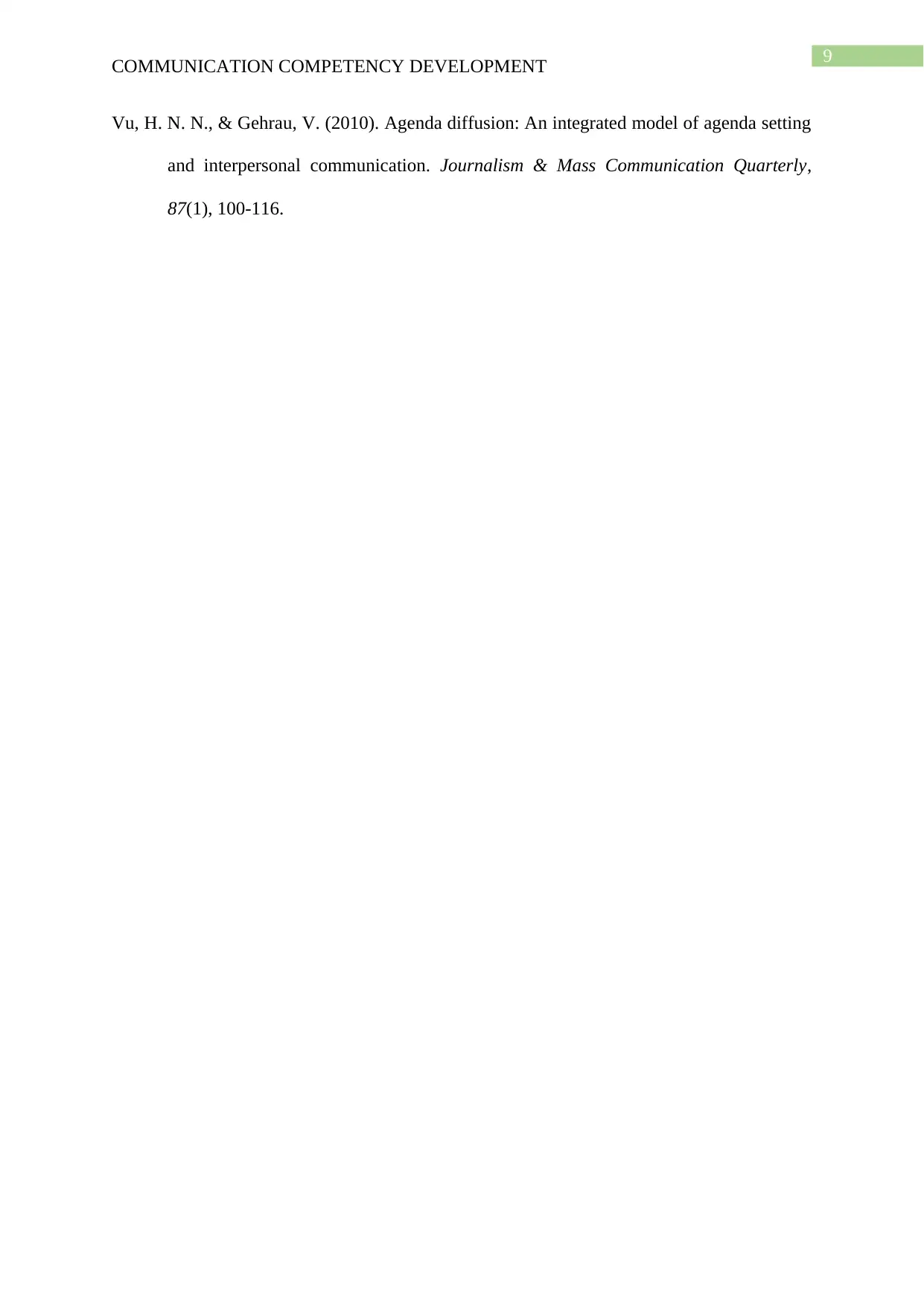
9
COMMUNICATION COMPETENCY DEVELOPMENT
Vu, H. N. N., & Gehrau, V. (2010). Agenda diffusion: An integrated model of agenda setting
and interpersonal communication. Journalism & Mass Communication Quarterly,
87(1), 100-116.
COMMUNICATION COMPETENCY DEVELOPMENT
Vu, H. N. N., & Gehrau, V. (2010). Agenda diffusion: An integrated model of agenda setting
and interpersonal communication. Journalism & Mass Communication Quarterly,
87(1), 100-116.
1 out of 10
Related Documents
Your All-in-One AI-Powered Toolkit for Academic Success.
+13062052269
info@desklib.com
Available 24*7 on WhatsApp / Email
![[object Object]](/_next/static/media/star-bottom.7253800d.svg)
Unlock your academic potential
© 2024 | Zucol Services PVT LTD | All rights reserved.





